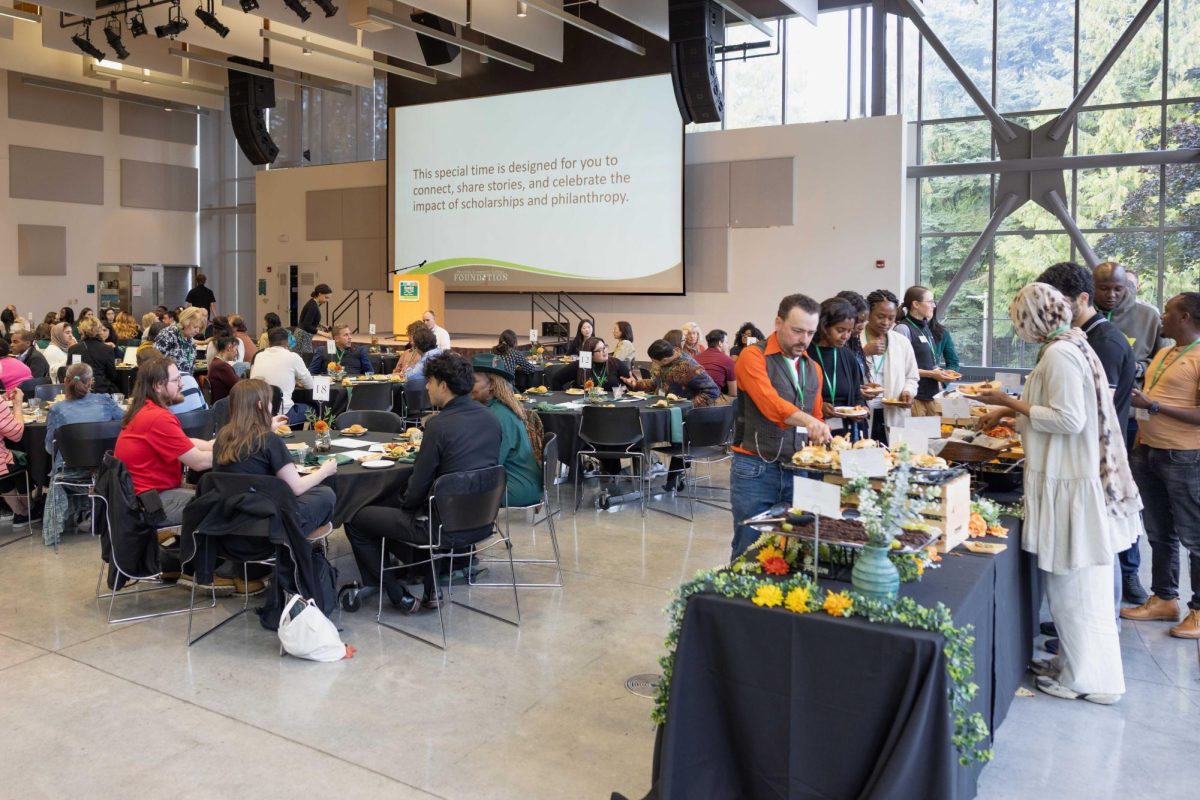All genders are now allowed to use the same restrooms in four different locations on campus (Photo Illustration by Martin Musialczyk)
By Cendri Johnson
Have you ever opened the door to the restroom and turned the corner to find yourself face to face with a member of the opposite sex? If not, then get ready to if you ever plan to visit the bathrooms on the first floor of the PUB again.
Both restrooms on the first floor of the PUB have been converted from sex-segregated to all-gender restrooms. According to Rezina Habtemariam, Director of Student Life at SCC, there are now four multi-stall all-gender restrooms on campus (located in the 2900, 1800 and PUB buildings), in addition to various single-stall unisex restrooms.
This year-long project, Habtemariam said, started in fall of 2015 after a student of Michelle Kleisath’s wrote a paper on gender-neutral bathrooms and proposed this idea for SCC. Soon after, a team was formed that included two of last year’s ASG officers, Emily Stensland and El Raven, as well as Habtemariam and Kleisath.
After much research on the single-stall bathrooms’ accessibility on campus and speaking to other community colleges from the region about their attempts at implementing similar projects, the team prepared a project proposal for the SCC council in the spring of 2016.
“In our proposal we addressed all of the misconceptions and common questions people had, I think because we did all of that people felt more open and comfortable with the idea,” Habtemariam said.
Some people from around the bookstore said that they think a better alternative would be installing a single-stall unisex bathroom instead of converting the multi-stall ones.
Habtemariam, however, explained that their course of action with making the multi-stall restrooms gender-neutral was driven not only by social motivations but also financial ones. “One of the reasons why we wanted to convert … the existing multi-stall restrooms into all-gender restrooms is because it was the most cost-effective option, so essentially the only cost we’re paying is removing urinals and also the cost of getting [all-gender restrooms] signs,” she said.
Despite the best intentions of these restrooms however, there does seem to be some trouble with them already.
School employees said that people (men in particular) have been going into the former men’s restroom and becoming frustrated with the cardboard covering the urinals. Habtemariam said, “Urinals are covered so they cannot be used, and then in the coming months we will permanently remove them.”
In the meantime, people have begun tearing the cardboard off the urinals and using them anyway.
One student, Renae Grimm, was not upset about this change in bathrooms, but surprised. When she walked out of what was the women’s restroom, not realizing that the restrooms had been converted to all-gender, she did double take when a man walked in the same door she’d just left.
“I thought (he) had made a mistake,” she said. She didn’t say anything to him, just walked away.
Grimm said that while she may feel uncomfortable using the bathroom while a man is in there, she hasn’t seen very many men frequenting the former women’s side of the restrooms, so for now she will continue to use the restrooms here on the first floor of the PUB.
Emily Valda, an employee at the SCC bookstore said that she and many other students are uncomfortable and don’t feel safe using the all-gender restrooms.
“I’ve just noticed the last couple times that I’ve gone by, I just feel like there is a bunch of mostly men just sitting around outside … I just can’t help but wonder if they’re looking at me and waiting to follow me. I’ve never seen that before, there’s just like a ton of guys who just sit out there now,” she said.
Valda also said that it’s annoying to have to use a different restroom now, as an employee of the bookstore. “Especially cause now you have to go all the way upstairs and now there (are) huge lines. Sometimes I have really short breaks and I don’t get to go to the bathroom at all.”
Valda said that she thinks the school should be focusing on making restrooms more accessible for people with disabilities rather than creating all-gender restrooms.
She said that she feels for the people these bathrooms were meant to benefit, but she doesn’t think this is the right solution.
“I want people to feel safe obviously, but I think it’s sort of putting a lot more people at risk … especially women and young girls,” she said. “I’m not a fan of it. Sorry.”
Raven, last year’s ASG governmental affairs officer, countered that nobody has to use the all-gender restroom if they don’t want to. The majority of restrooms on campus, he said, remain traditionally sex-segregated. Within the sex-segregated bathrooms, however, people are still allowed to use whichever side they identify with (even though not all identify as strictly male or female). The four multi-stall gender-neutral bathrooms, Habetmariam added, are the only ones — they will not be converting any more.
While these bathrooms may pose an inconvenience to some, they really are helping people as well. “These bathrooms allow me, as a transgender person, and many of my gender-nonconforming friends and peers to have access to a facility where our appearance cannot be used as grounds for others to tell us we are ‘in the wrong bathroom’ or ‘need to get out,’” Raven said.
Adding onto this message of social progress, Habtemariam said, “It’s important to acknowledge that not everyone identifies with the gender binary … Having the restrooms continue to still be labeled male and female or men and women would still be forcing people to choose a specific gender and that perpetuates the idea that there are only two genders.”
The team behind the change will consider it a success if it helps someone feel more comfortable on campus.
“This initiative was designed to create another option for anyone, regardless of gender identity, to use the bathroom in peace,” Raven said.













